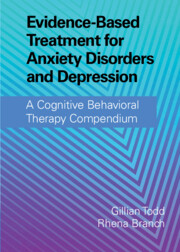 Evidence-Based Treatment for Anxiety Disorders and Depression
Evidence-Based Treatment for Anxiety Disorders and Depression from Part One - Cognitive Behavioral Therapy for Anxiety Disorders
Published online by Cambridge University Press: 06 January 2022
Although fear can protect us from harm and prepare us for danger, disproportionately extreme fear can turn into a specific phobia when it leads to extreme avoidance of and distress in feared situations, thereby interfering with our lives and mental well-being. This chapter gives instructions and examples of how an assessment and mini formulation for specific phobias can help to construct a ‘fear hierarchy’ and to understand which ‘safety behaviors’ can maintain phobias. With case illustrations, the chapter describes how to apply exposure therapy, the cornerstone CBT method for specific phobias, in which an individual gradually confronts each trigger in the fear hierarchy while refraining from safety behaviors. The chapter also outlines how to overcome common difficulties with exposure therapy and how to measure therapy outcomes. Finally, cognitive restructuring is discussed as a CBT approach for specific phobias in which exposure-based activities are used to test and challenge exaggerated or unhelpful ideas about feared situations.
This is the definitive guide on CBT for specific phobias. The first part of
the book gives an extensive background on the phenomenology and
assessment of specific phobias; it also gives an overview of the evidence
for various treatments for specific phobias. The second part of the book
focuses on one-session treatment for specific phobias with adults and
children. It gives detailed instructions and treatment plans and materials
on how to conduct one-session treatments. The last part of the book
addresses special topics in CBT for specific phobias, including how to
train therapists and assess their competence, how to adapt the treatment
for specialist populations (e.g., people with learning or developmental
difficulties), ethical issues, research evidence, and use of technologies.
To save this book to your Kindle, first ensure [email protected] is added to your Approved Personal Document E-mail List under your Personal Document Settings on the Manage Your Content and Devices page of your Amazon account. Then enter the ‘name’ part of your Kindle email address below. Find out more about saving to your Kindle.
Note you can select to save to either the @free.kindle.com or @kindle.com variations. ‘@free.kindle.com’ emails are free but can only be saved to your device when it is connected to wi-fi. ‘@kindle.com’ emails can be delivered even when you are not connected to wi-fi, but note that service fees apply.
Find out more about the Kindle Personal Document Service.
To save content items to your account, please confirm that you agree to abide by our usage policies. If this is the first time you use this feature, you will be asked to authorise Cambridge Core to connect with your account. Find out more about saving content to Dropbox.
To save content items to your account, please confirm that you agree to abide by our usage policies. If this is the first time you use this feature, you will be asked to authorise Cambridge Core to connect with your account. Find out more about saving content to Google Drive.